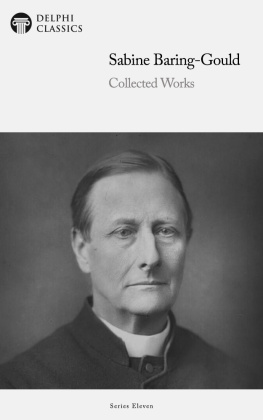S. (Sabine) Baring-Gould - An Old English Home and Its Dependencies
Here you can read online S. (Sabine) Baring-Gould - An Old English Home and Its Dependencies full text of the book (entire story) in english for free. Download pdf and epub, get meaning, cover and reviews about this ebook. year: 2021, publisher: Litres, genre: Detective and thriller. Description of the work, (preface) as well as reviews are available. Best literature library LitArk.com created for fans of good reading and offers a wide selection of genres:
Romance novel
Science fiction
Adventure
Detective
Science
History
Home and family
Prose
Art
Politics
Computer
Non-fiction
Religion
Business
Children
Humor
Choose a favorite category and find really read worthwhile books. Enjoy immersion in the world of imagination, feel the emotions of the characters or learn something new for yourself, make an fascinating discovery.

- Book:An Old English Home and Its Dependencies
- Author:
- Publisher:Litres
- Genre:
- Year:2021
- Rating:3 / 5
- Favourites:Add to favourites
- Your mark:
- 60
- 1
- 2
- 3
- 4
- 5
An Old English Home and Its Dependencies: summary, description and annotation
We offer to read an annotation, description, summary or preface (depends on what the author of the book "An Old English Home and Its Dependencies" wrote himself). If you haven't found the necessary information about the book — write in the comments, we will try to find it.
S. (Sabine) Baring-Gould: author's other books
Who wrote An Old English Home and Its Dependencies? Find out the surname, the name of the author of the book and a list of all author's works by series.
An Old English Home and Its Dependencies — read online for free the complete book (whole text) full work
Below is the text of the book, divided by pages. System saving the place of the last page read, allows you to conveniently read the book "An Old English Home and Its Dependencies" online for free, without having to search again every time where you left off. Put a bookmark, and you can go to the page where you finished reading at any time.
Font size:
Interval:
Bookmark:

156 FIFTH AVENUE, : NEW YORK
THE QUEEN OF LOVE
URITH
CHEAP JACK ZITA
MRS. CURGENVEN OF CURGENVEN
ARMINELL
KITTY ALONE
MARGERY OF QUETHER
JACQUETTA
NOMI
THE BROOM-SQUIRE
DARTMOOR IDYLLS
THE PENNYCOMEQUICKS
GUAVAS THE TINNER
BLADYS OF THE STEWPONEY
OLD ENGLISH HOME
AND ITS DEPENDENCIES
36 ESSEX STREET, W.C.
LONDON
1898
[ix]
| CHAPTER | PAGE |
| I. | Paternal Acres |
| II. | The Manor House |
| III. | The Domestic Hearth |
| IV. | Old Furniture |
| V. | Ceilings |
| VI. | The Parish Church |
| VII. | The Village Inn |
| VIII. | The Manor Mill |
| IX. | The Farmhouse |
| X. | Cottages |
| XI. | The Village Doctor |
| XII. | Scapegraces |
| XIII. | Hedges |
| XIV. | Underground Rights |
| PAGE |
| An Old English Home |
| Marianne's Cottage |
| The Cottage of the "Savages" |
| The Manor House, South Wraxall, Wiltshire |
| Chateau de Tumilhac |
| Battlemented Transom |
| A Chimney-piece (End of Seventeenth Century) |
| The Settle |
| The Chimney-top, Ancient and Modern |
| Fireplace and Chimney-piece, York |
| Chair (1840) |
| Chair (Sixteenth Century) |
| A Chest of Drawers (1652) |
| The Livery Cupboard |
| Portion of an Old Plaster Ceiling near Leeds |
| The Drawing-room, Dunsland, Devon |
| The Old Pulpit, Kenton |
| The Modern-Gothic Pulpit, Kenton |
| Staverton Rood Screen |
| Inside the Village Inn |
| The Old George Inn, Glastonbury |
| Old Mill in Cornwall |
| Plan of Buildings at Anseremme |
| Anseremme, on the Meuse |
| An Essex Farmhouse |
| Old Cottages at Henbury |
| Wonson Manor |
| Alabaster Slab with Footprints, Vatican, Rome |
| Devonshire Hedges |
Font size:
Interval:
Bookmark:
Similar books «An Old English Home and Its Dependencies»
Look at similar books to An Old English Home and Its Dependencies. We have selected literature similar in name and meaning in the hope of providing readers with more options to find new, interesting, not yet read works.
Discussion, reviews of the book An Old English Home and Its Dependencies and just readers' own opinions. Leave your comments, write what you think about the work, its meaning or the main characters. Specify what exactly you liked and what you didn't like, and why you think so.


